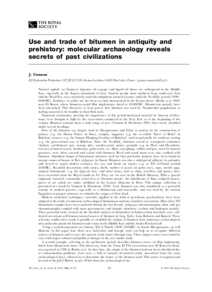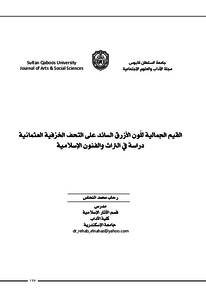وثيقة
Use and trade of bitumen in antiquity and prehistory : molecular archaeology reveals secrets of past civilizations.
المعرف
DOI: 10.1098/rstb.1999.0358
المصدر
Philosophical Transactions of the Royal Society B: Biological Sciences. v. 354, 1379, p. 33-50
الدولة
United Kingdom.
مكان النشر
London.
الناشر
Royal Society.
ميلادي
1999-01-29
اللغة
الأنجليزية
الموضوع
الملخص الإنجليزي
Natural asphalt (or bitumen) deposits, oil seepage and liquid oil shows are widespread in the Middle East, especially in the Zagros mountains of Iran. Ancient people from northern Iraq, south-west Iran and the Dead Sea area extensively used this ubiquitous natural resource until the Neolithic period (7000-6000 BC). Evidence of earlier use has been recently documented in the Syrian desert (Boeda et al. 1996) near El Kown, where bitumen-coated flint implements, dated to 40 000BC (Mousterian period), have been unearthed. This discovery at least proves that bitumen was used by Neanderthal populations as halting material to fix handles to their flint tools. Numerous testimonies, proving the importance of this petroleum-based material in Ancient civilizations, were brought to light by the excavations conducted in the Near East as of the beginning of the century. Bitumen remains show a wide range of uses (Connan and Deschesne 1995) that can be classified under several headings. First of all, bitumen was largely used in Mesopotamia and Elam as mortar in the construction of palaces (e.g. the Darius Palace in Susa), temples, ziggurats (e.g. the so-called 'Tower of Babel' in Babylon), terraces (e.g. the famous 'Hanging Gardens of Babylon') and exceptionally for roadway coating (e.g. the processional way of Babylon). Since the Neolithic, bitumen served to waterproof containers (baskets, earthenware jars, storage pits), wooden posts, palace grounds (e.g. in Mari and Haradum), reserves of lustral waters, bathrooms, palm roofs, etc. Mats, sarcophagi, coffins and jars, used for funeral practices, were often covered and sealed with bitumen. Reed and wood boats were also caulked with bitumen. Abundant lumps of bituminous mixtures used for that particular purpose have been found in storage rooms of houses at Ra's al-Junayz in Oman. Bitumen was also a widespread adhesive in antiquity and served to repair broken ceramics, fix eyes and horns on statues (e.g. at Tell al-Ubaid around 2500 BC). Beautiful decorations with stones, shells, mother of pearl, on palm trees, cups, ostrich eggs, musical instruments (e.g. the Queen's lyre) and other items, such as rings, jewellery and games, have been excavated from the Royal tombs in Ur. They are on view in the British Museum. With a special enigmatic material, commonly referred to as 'bitumen mastic, the inhabitants of Susa sculpted masterpieces of art which are today exhibited in the Louvre Museum in Paris. This unique collection is presented in a book by Connan and Deschesne (1996). Last, bitumen was also considered as a powerful remedy in medical practice, especially as a disinfectant and insecticide, and was used by the ancient Egyptians to prepare mixtures to embalm the corpses of their dead. Modern analytical techniques, currently applied in the field of petroleum geochemistry, have been adapted to the study of numerous archaeological bituminous mixtures found in excavations. More than 700 bituminous samples have been analysed during the last decade, using gas chromatography alone and gas chromatography coupled with mass spectrometry and isotopic chemistry (carbon and hydrogen mainly). These powerful tools, focused on the detailed analysis of biomarkers in hydrocarbon fractions, were calibrated on various well-known natural sources of bitumen in Iraq, Syria, Iran, Bahrain and Kuwait. These reference studies have made it possible to establish the origins of bitumen from numerous archaeological sites and to document the bitumen trade routes in the Middle East and the Arabo-Persian Gulf. Using a well-documented case history, Tell el 'Oueili (5800-3500 BC) in South Mesopotamia, we will illustrate in this paper how these new molecular and isotopic tools can help us to recognize different sources of bitumen and to trace the ancient trade routes through time. These import routes were found to vary with major cultural and political changes in the area under study. A second example, referring to the prehistoric period, describes bitumen traces on flint implements, dated from Mousterian times. This discovery, from the Umm El Tlel excavations near El Kown in Syria, was reported in 1996 in Boeda et al. At that time, the origin of the bitumen had not been elucidated due to contamination problems. Last year, a ball of natural oil-stained sands, unearthed from the same archaeological layer, allowed us to determine the source of the bitumen used. This source is regional and located in the Jebel Bichri, nearly 40 km from the archaeological site. The last case history was selected to illustrate another aspect of the investigations carried out. Recent geochemical studies on more than 20 balms from Egyptian mummies from the Intermediate, Ptolemaic and Roman periods have revealed that these balms are composed of various mixtures of bitumen, conifer resins, grease and beeswax. Bitumen occurs with the other ingredients and the balms studied show a great variety of molecular compositions (Connan 1998). Bitumen from the Dead Sea area is the most common source but some other sources (Hit in Iraq?) are also revealed by different molecular patterns. The absolute amount of bitumen in balms varies from almost zero to 30% per weight (Connan and Dessort 1991; Connan 1998).
ISSN
0962-8436
قالب العنصر
مقالات الدوريات


